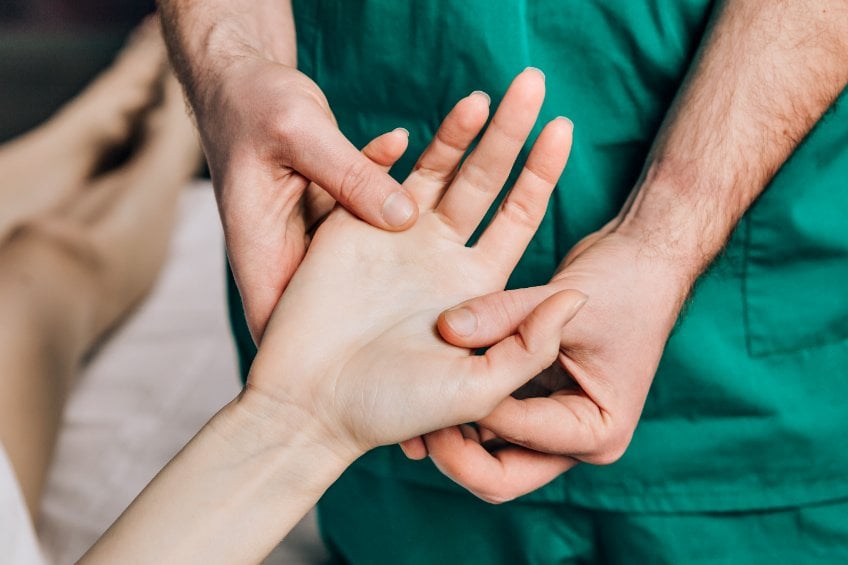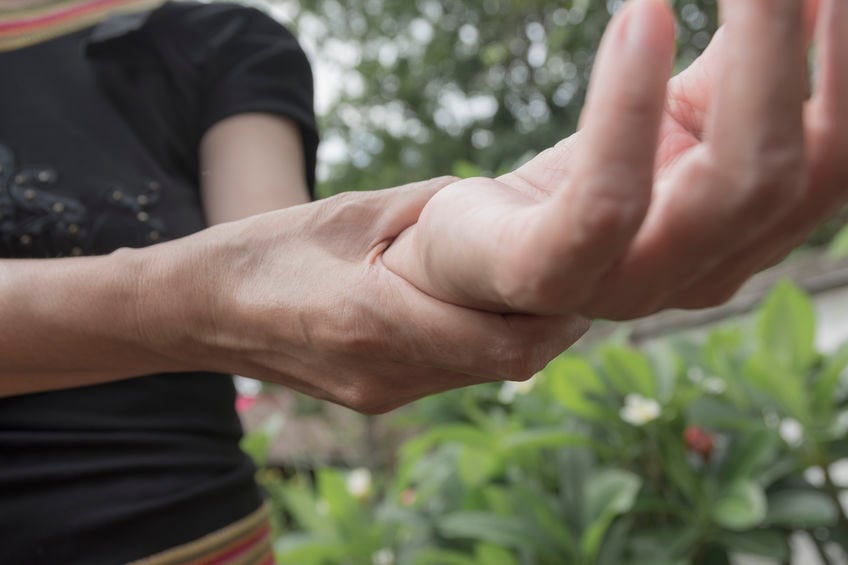Can You Get Arthritis Under Your Thumb?
Arthritis can target almost any of the over 200 joints in the body, and the thumb is no exception. Covering the ends of each joint is smooth cartilage that helps with shock absorption and flexibility. Should that cartilage wear away, the resulting inflammation and rubbing causes pain and stiffness. Some smaller joints, like the thumb, develop arthritis, but many patients ignore the signs. With age, thumb arthritis becomes more severe, limiting digit use. Arthritis usually occurs at the carpometacarpal (CMC) joint, located at the base of the thumb. If a thumb CMC arthroplasty is necessary, there will be some time before patients can return to work.

What causes thumb arthritis?
The thumb plays a part in almost any function involving the hand. So, for many, thumb arthritis is a natural consequence of aging. This wear and tear is common among former athletes and jobs requiring repetitive thumb use. The risk of arthritis increases with obesity, diabetes, and rheumatoid arthritis. Pain is not the only symptom patients experience. Swelling, weakness, and a deformed joint are also common. Surgery is best for patients who no longer respond to treatment or find that the condition limits work and social activities.
Time for surgery
The goal of surgery is to remove damaged bone and reconstruct the joint. The procedure will happen with the patient under general or local anesthesia. The surgeon makes an incision at the base of the thumb, then carefully moves the nerves, tissues, and radial artery. The damaged bone is removed, leaving a vacant space at the CMC joint. A nearby flexor carpi radialis (FCR) tendon is cut and then passed through a hole made in the bone. The excess tendon is then folded into the area to create a spacer. In some cases, an artificial spacer or graft is used instead. The surgeon will close the incision with stitches, then secure the hand with a soft cast.
CMC Arthroplasty recovery
The thumb remains in the cast for 2-3 weeks. Pain management and wound care are critical during this time. The surgeon will remove stitches after 2 weeks, then apply a removable splint. From that point, the patient will need physical therapy and strengthening exercises for a speedy recovery. This period can last as long as 6-8 weeks. At the 12-week mark, some light activities are allowed. CMC requires several months of healing and can take up to a year for the patient to recover. During this time, the tendon spacer strengthens by turning into scar tissue.
How soon can you return to work?
Some patients can return to work at the 2-4-week mark for light activities. If this is the patient’s dominant hand, eating, typing, and other light activities are allowed. Patients who use the thumbs repeatedly, like office jobs, may need additional time or rest between jobs. Jobs that require heavy lifting are not encouraged until 12 weeks. Even then, some patients need extra recovery time.
Thumbs up for CMC arthroplasty
The swelling, pain, and discomfort of thumb arthritis can stop anyone from working. Surgery aims to remove the diseased joint and fill the space with a tendon or graft. Recovery is just as important as surgery, with consistent physical therapy required. Light work is possible and encouraged after a few weeks. Therefore, patients should get the necessary time off for recovery before opting for surgery.
Can Lower Back Pain Return After Spinal Surgery? 3 Lifestyle Changes To Get The Most Out Of Fusion
Minnesota Valley Valley Center2024-04-02T14:49:38-05:00April 15th, 2024|
Spinal surgery is an excellent solution for lower back pain, but symptoms can return. With lifestyle changes, patients can get the most out of fusion.
A New Lease On Life: Exploring How Robotic Total Joint Replacement Can Get You Active Again
Minnesota Valley Valley Center2024-03-24T17:38:47-05:00March 29th, 2024|
Robotic total joint replacement uses a robotic arm to replace the joint. This innovative approach allows a quick return to activities.
Restoring Dexterity: How Outpatient Carpal Tunnel Surgery Can Change Your Life
Minnesota Valley Valley Center2024-03-24T17:38:37-05:00March 15th, 2024|
After months of wrist and hand pain, carpal tunnel surgery may be needed. With outpatient options, restored dexterity with less pain and discomfort is possible.
More Articles from MVSC
March 15, 2024
After months of wrist and hand pain, carpal tunnel surgery may be needed. With outpatient options, restored dexterity with less pain and discomfort is possible.
November 14, 2023
Recovery from ulnar nerve release surgery can take up to 8 weeks. With a strong healthcare team and strategies, the pain can be minimized.
October 27, 2023
People with thumb arthritis can experience pain when using a smartphone. A CMC arthroplasty can help individuals get back to texting pain-free.
August 25, 2023
When the wrist is fractured, people wonder how to repair the bone. Minimally invasive surgery can help restore function and decrease pain.










